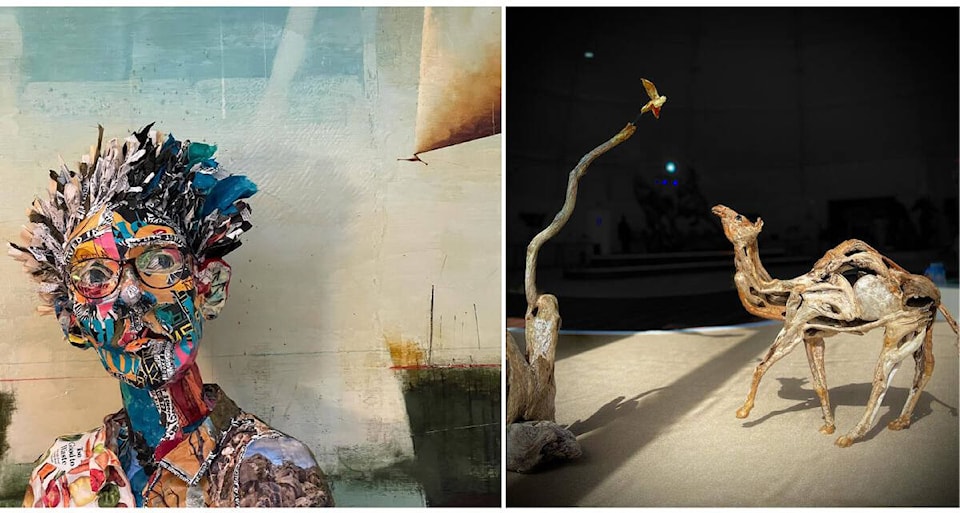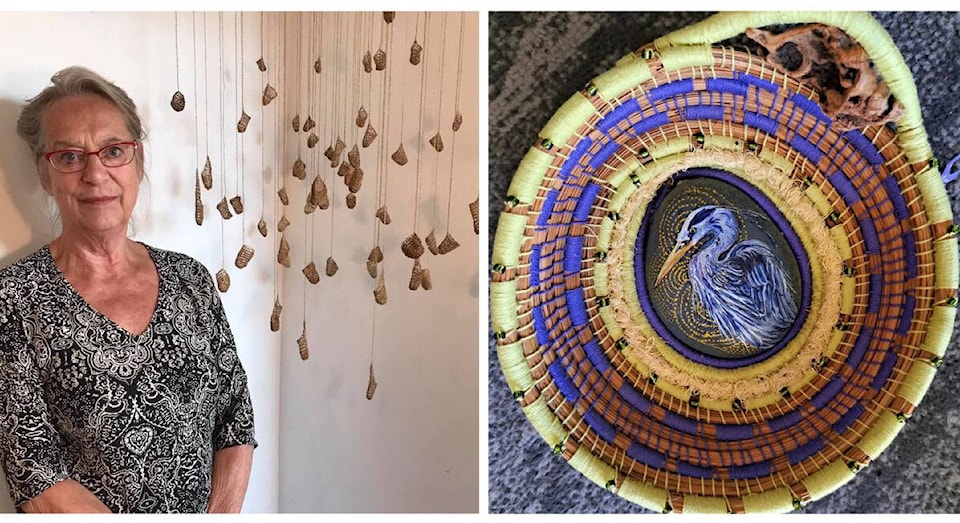Art
'It is magical': repurposed art growing in B.C. along with eco-consciousness – Chilliwack Progress
Victoria artist Beverly Hancock used to paint a painting and be done. But now, she cuts it up. And then, she weaves it into something new.
Karen Guilbault gathers pine needles – sometimes she’ll even politely ask city removal not to rake over a spot. She then patiently bundles and weaves them into intricate baskets.
Award-winning fibre artist Martina Edmondson now makes whimsical creations out of nature foragings.
These women are all established artists riding the waves of a rising tide: the growing trend of repurposed art. Essentially, it’s using found or existing objects to create something entirely new.
“It’s a huge trend in the world, but the biggest trend is to use garbage and reuse things that we don’t think are beautiful,” Hancock said. “And to try to make something that no one’s ever seen before out of something you would usually throw out.”


In February, another ‘repurposed’ artist from Victoria, driftwood sculptor Tanya Bub, was at an international exposition of repurposed art in Qatar called the Tadweer Art Exhibition. The exhibit merged the worlds of art and environmental consciousness, stated to be a testament to Qatar’s commitment to sustainability.
For artists who approach art through this lens, the draw lies in reconnecting with the natural world while relinquishing control and embracing spontaneity.
“I start with something that I find really interesting,” Edmondson said of her diverse pieces, which include collage, sculpture and eco printing (using natural materials to dye paper with earthy tones and create imprints). “I might think, oh, maybe this looks a little bit like a face or this could be an eagle. And then my imagination takes a flight.”
She also does embroidery, but, “It’s not pretty embroidery. I guess I don’t do pretty very well. Or, I don’t find it pretty.”
Pretty isn’t the point when approaching art in this manner. “You’re making it for yourself. And I think that comes with age,” Edmondson said.
Hancock, an expressionist and figurative artist who finds it “exhilarating” to rip up and re-imagine her paintings into new works, agreed this is a new era of art-making for her. “It is really interesting to see how artists’ work changes as their situation in life changes.”


A growing eco-consciousness in the arts community
While repurposed art has always been around, all three artists said they’ve seen it growing in popularity, all part of a growing eco-consciousness.
“I think with the way climate change is going, there will be more and more emphasis on, what are we using? What are we doing to the environment?” Edmondson said.
“I’m not saying everybody’s there, but, you know, I have a big following online. It’s a very big topic,” Hancock said.
“Many, many artists would say, ‘There’s no paper towel in my studio. I’m using rags.’ So if you can’t do everything, you’re trying to do something, right? And I think every artist is sharing that information with each other.”
Guilbault primarily uses pine needles to create her baskets. But she also paints stones to feature in the centre of these baskets, and once she’s done painting, she wipes her palette so the paint doesn’t go down the drain.
“You see how we are all thinking about it,” Hancock said. “When I went to art school, what a squiggle of time ago, in the 1970s, nobody talked about that. There wasn’t a single person in the art world that had ever even discussed, what do we do with this paint? Is it bad for the world?”
Experience repurposed art
While the artists just wrapped up a group exhibit at Gage Gallery in March, Beverly Hancock will be exhibiting at Gage again April 2-14 with RAW: Unveiled Layers, which delves into the raw experiences that shape the human condition.
If you are interested in this type of artwork you can also check out art by Gerhard Bär, Martha Haversham, Michelle Reader, Wim Delvoye and Yuken Teruya.
But Hancock, Guilbault and Edmondson would probably also encourage you to try it out for yourself.
“It is magical. After you get going, you go, ‘I could have never thought of that’,” Hancock said.
READ MORE: Spring into art galleries in Victoria
Art
Art and Ephemera Once Owned by Pioneering Artist Mary Beth Edelson Discarded on the Street in SoHo – artnet News
This afternoon in Manhattan’s SoHo neighborhood, people walking along Mercer Street were surprised to find a trove of materials that once belonged to the late feminist artist Mary Beth Edelson, all free for the taking.
Outside of Edelson’s old studio at 110 Mercer Street, drawings, prints, and cut-out figures were sitting in cardboard boxes alongside posters from her exhibitions, monographs, and other ephemera. One box included cards that the artist’s children had given her for birthdays and mother’s days. Passersby competed with trash collectors who were loading the items into bags and throwing them into a U-Haul.
“It’s her last show,” joked her son, Nick Edelson, who had arranged for the junk guys to come and pick up what was on the street. He has been living in her former studio since the artist died in 2021 at the age of 88.
Naturally, neighbors speculated that he was clearing out his mother’s belongings in order to sell her old loft. “As you can see, we’re just clearing the basement” is all he would say.


Photo by Annie Armstrong.
Some in the crowd criticized the disposal of the material. Alessandra Pohlmann, an artist who works next door at the Judd Foundation, pulled out a drawing from the scraps that she plans to frame. “It’s deeply disrespectful,” she said. “This should not be happening.” A colleague from the foundation who was rifling through a nearby pile said, “We have to save them. If I had more space, I’d take more.”
Edelson’s estate, which is controlled by her son and represented by New York’s David Lewis Gallery, holds a significant portion of her artwork. “I’m shocked and surprised by the sudden discovery,” Lewis said over the phone. “The gallery has, of course, taken great care to preserve and champion Mary Beth’s legacy for nearly a decade now. We immediately sent a team up there to try to locate the work, but it was gone.”
Sources close to the family said that other artwork remains in storage. Museums such as the Guggenheim, Tate Modern, the Museum of Modern Art, the Brooklyn Museum, and the Whitney currently hold her work in their private collections. New York University’s Fales Library has her papers.
Edelson rose to prominence in the 1970s as one of the early voices in the feminist art movement. She is most known for her collaged works, which reimagine famed tableaux to narrate women’s history. For instance, her piece Some Living American Women Artists (1972) appropriates Leonardo da Vinci’s The Last Supper (1494–98) to include the faces of Faith Ringgold, Agnes Martin, Yoko Ono, and Alice Neel, and others as the apostles; Georgia O’Keeffe’s face covers that of Jesus.


A lucky passerby collecting a couple of figurative cut-outs by Mary Beth Edelson. Photo by Annie Armstrong.
In all, it took about 45 minutes for the pioneering artist’s material to be removed by the trash collectors and those lucky enough to hear about what was happening.
Dealer Jordan Barse, who runs Theta Gallery, biked by and took a poster from Edelson’s 1977 show at A.I.R. gallery, “Memorials to the 9,000,000 Women Burned as Witches in the Christian Era.” Artist Keely Angel picked up handwritten notes, and said, “They smell like mouse poop. I’m glad someone got these before they did,” gesturing to the men pushing papers into trash bags.
A neighbor told one person who picked up some cut-out pieces, “Those could be worth a fortune. Don’t put it on eBay! Look into her work, and you’ll be into it.”
Follow Artnet News on Facebook:
Want to stay ahead of the art world? Subscribe to our newsletter to get the breaking news, eye-opening interviews, and incisive critical takes that drive the conversation forward.
Art
Biggest Indigenous art collection – CTV News Barrie
[unable to retrieve full-text content]
Biggest Indigenous art collection CTV News Barrie





Source link
Art
Why Are Art Resale Prices Plummeting? – artnet News


Welcome to the Art Angle, a podcast from Artnet News that delves into the places where the art world meets the real world, bringing each week’s biggest story down to earth. Join us every week for an in-depth look at what matters most in museums, the art market, and much more, with input from our own writers and editors, as well as artists, curators, and other top experts in the field.
The art press is filled with headlines about trophy works trading for huge sums: $195 million for an Andy Warhol, $110 million for a Jean-Michel Basquiat, $91 million for a Jeff Koons. In the popular imagination, pricy art just keeps climbing in value—up, up, and up. The truth is more complicated, as those in the industry know. Tastes change, and demand shifts. The reputations of artists rise and fall, as do their prices. Reselling art for profit is often quite difficult—it’s the exception rather than the norm. This is “the art market’s dirty secret,” Artnet senior reporter Katya Kazakina wrote last month in her weekly Art Detective column.
In her recent columns, Katya has been reporting on that very thorny topic, which has grown even thornier amid what appears to be a severe market correction. As one collector told her: “There’s a bit of a carnage in the market at the moment. Many things are not selling at all or selling for a fraction of what they used to.”
For instance, a painting by Dan Colen that was purchased fresh from a gallery a decade ago for probably around $450,000 went for only about $15,000 at auction. And Colen is not the only once-hot figure floundering. As Katya wrote: “Right now, you can often find a painting, a drawing, or a sculpture at auction for a fraction of what it would cost at a gallery. Still, art dealers keep asking—and buyers keep paying—steep prices for new works.” In the parlance of the art world, primary prices are outstripping secondary ones.
Why is this happening? And why do seemingly sophisticated collectors continue to pay immense sums for art from galleries, knowing full well that they may never recoup their investment? This week, Katya joins Artnet Pro editor Andrew Russeth on the podcast to make sense of these questions—and to cover a whole lot more.
Follow Artnet News on Facebook:
Want to stay ahead of the art world? Subscribe to our newsletter to get the breaking news, eye-opening interviews, and incisive critical takes that drive the conversation forward.
-
Media15 hours ago
DJT Stock Rises. Trump Media CEO Alleges Potential Market Manipulation. – Barron's
-
Media17 hours ago
Trump Media alerts Nasdaq to potential market manipulation from 'naked' short selling of DJT stock – CNBC
-
Investment16 hours ago
Private equity gears up for potential National Football League investments – Financial Times
-



 Sports20 hours ago
Sports20 hours ago2024 Stanley Cup Playoffs 1st-round schedule – NHL.com
-
Real eState8 hours ago
Botched home sale costs Winnipeg man his right to sell real estate in Manitoba – CBC.ca
-
Business16 hours ago
Gas prices see 'largest single-day jump since early 2022': En-Pro International – Yahoo Canada Finance
-
Art19 hours ago
Enter the uncanny valley: New exhibition mixes AI and art photography – Euronews
-
News14 hours ago
Canada Child Benefit payment on Friday | CTV News – CTV News Toronto




